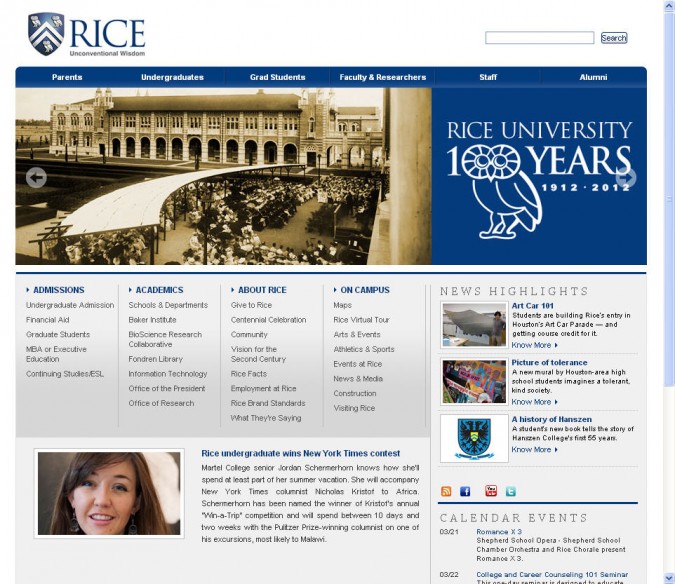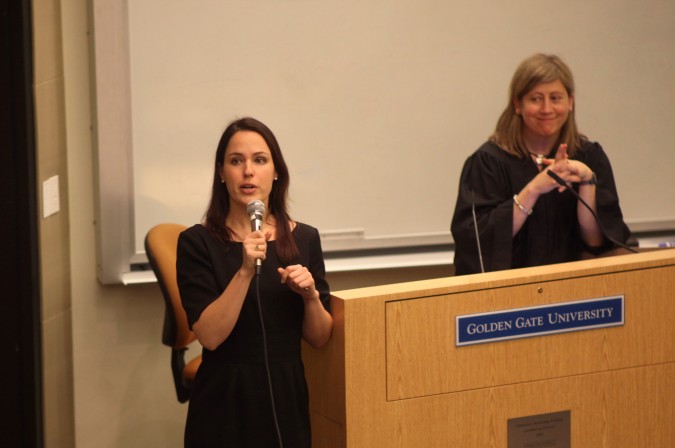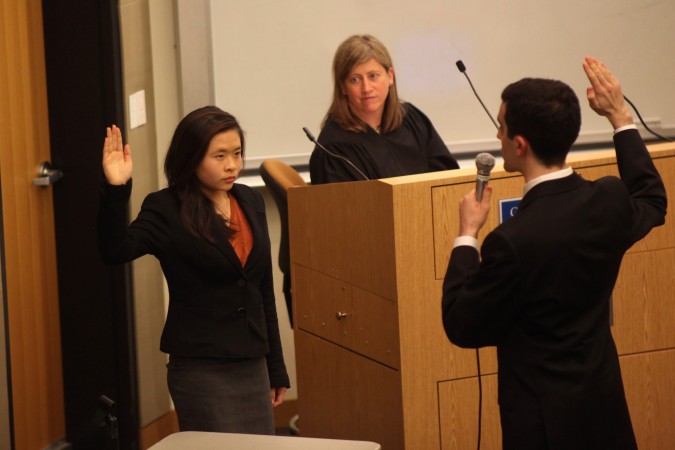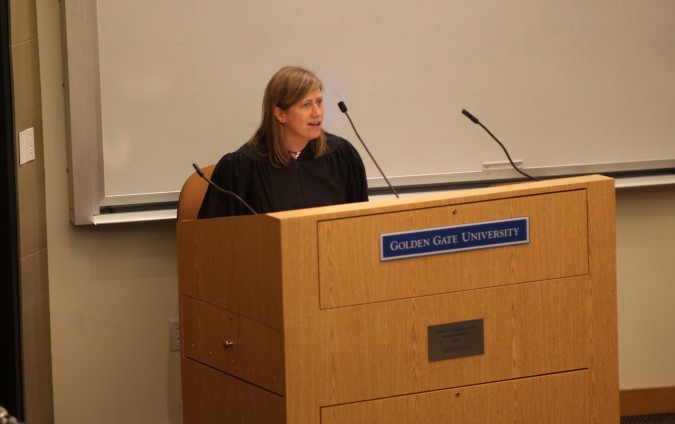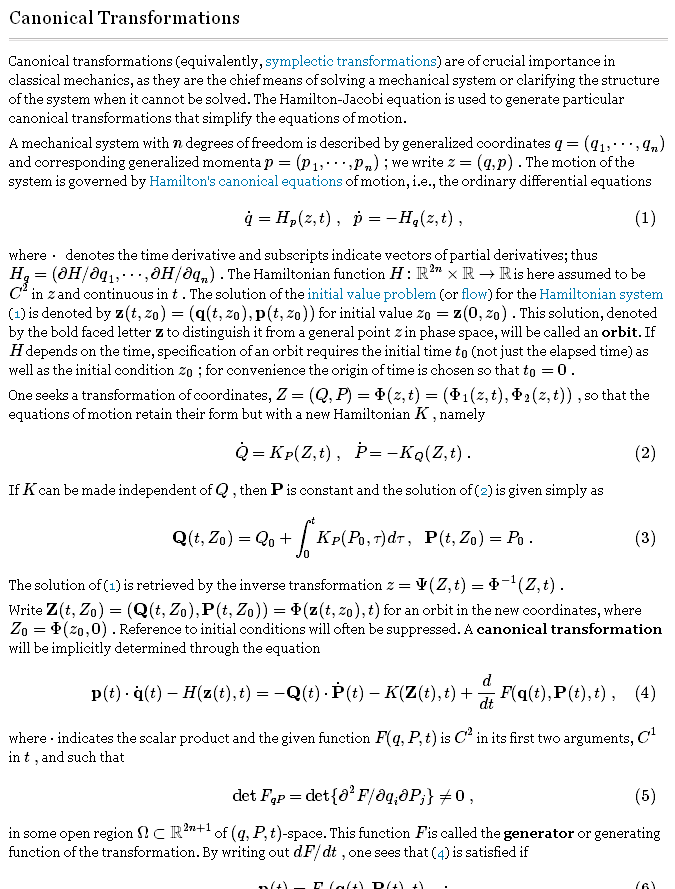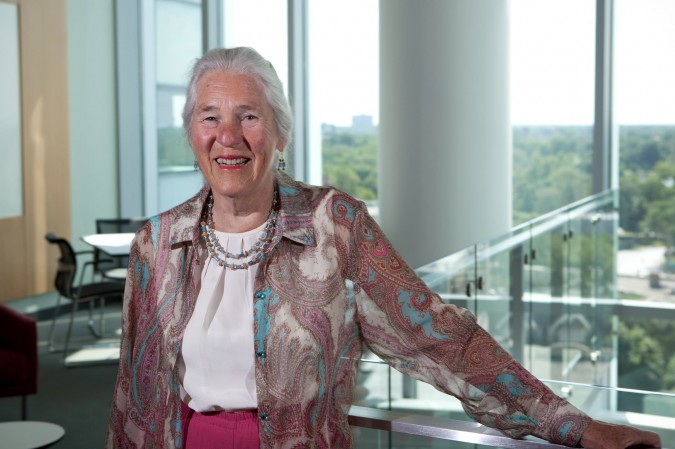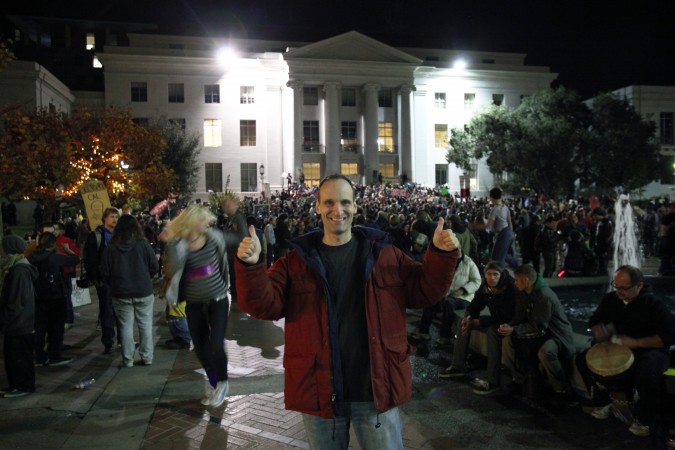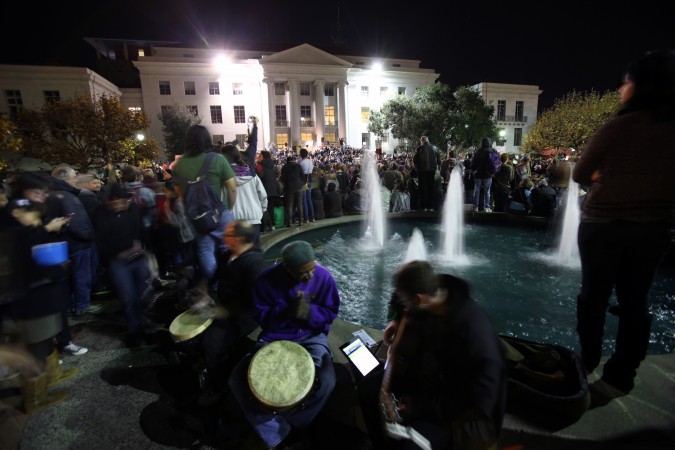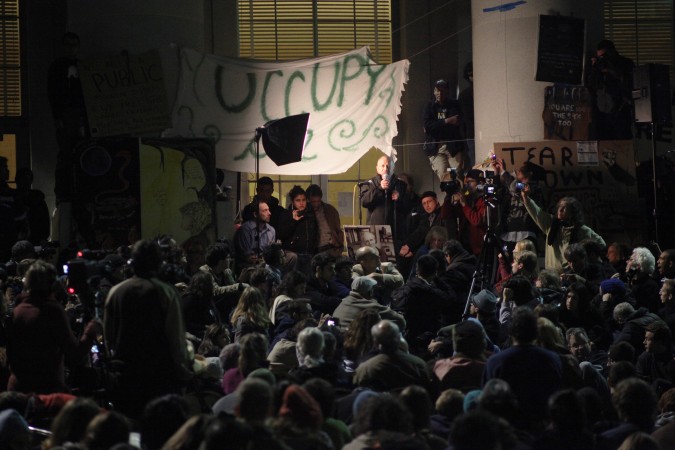Archive for the ‘Education’ Category
Trash Chaos iPad and iPhone children’s educational game demonstrated by Yogome.com co-founder Manolo Diaz
When I was at the Demo Day a week ago for the first graduating class for mexican.vc, I got to meet Manolo Diaz, a co-founder of Yogome.
mexican.vc is a seed stage venture capital firm that invested in Yogome. I was at the Demo Day because I know one of the people at mexican.vc.
Yogome makes educational software for the Apple iPad device and the Apple iPhone smartphone. Yogome apps are games that educate. They are fun, beautiful and engaging. If I had an iPad I would download them.
Diaz was kind enough to demonstrate the game Trash Chaos, which requires students to sort trash they see on the ground into the proper recycling bins. As students get faster and more accurate, more trash appears, as do more recycling bins.
I put Diaz on the spot by proposing he demonstrate Trash Chaos while I captured video. The room was filled with people talking, but Diaz still put on a great demo that’s articulate and approachable. I present the full unedited demo above.
Diaz gave me a Yogome large size t-shirt to give to a lucky reader of my blog.
I haven’t given anything away on my blog before, so this is exciting.
What I’m going to do is mail the brand new shirt with the tags still attached to the first person to Tweet this blog post to at least 100 of their followers. Alert me that you have done this by leaving me a comment here with your Twitter handle. You can be anywhere in the world, and I will pay the postage to send the shirt to you. Remember, it’s a men’s size large, not a children’s shirt.
Trash Chaos was the number 10 Apple App Store app in its category of free educational software on March 16, 2012, the day I made the accompanying video.
Great job Yogome!
Jordan Schermerhorn wins New York Times trip to Africa with columnist and blogger Nicholas Kristof
Here’s a great essay by undergraduate Rice University student Jordan Schermerhorn.
Schermerhorn wrote this engaging piece to try win a trip with New York Times newspaper columnist Nicholas Kristof.
I follow Kristof on Facebook, and that’s how I found Schermerhorn’s essay.
I am reprinting Schermerhorn’s essay in its entirety here because I don’t think she will object, given she wrote this knowing it could receive widespread public attention. Furthermore, this is not New York Times text, but Schermerhorn’s personal text. Of course I’ll remove this text if asked by Schermerhorn or The New York Times.
As you can see above, Rice University devoted prime space on the front of their website telling the world of Schermerhorn’s win.
According to the Rice story about Schermerhorn’s win, she will travel with Kristof to Africa and will blog for The New York Times during her trip. How exciting! I am really happy for her.
What Scermerhorn has written is inspiring and powerful. She’s a good writer. I predict she will do great things in life. Her heart is in the right place.
I identify strongly with what Schermerhorn has written.
I plan to tour the US and world in my super green 4 cylinder bus conversion to advance the idea that we can tread far more lightly on the planet with existing technologies if we would only change our perspective on what it means to be happy. I am exchanging heaps of easy cash I could make by writing code for established companies to pursue my desire to help save the world. I can get by just fine on the more modest cash I make working for myself and managing my investments. I can do this and write at the same time.
Scermerhorn says she wants to help her fellow classmates pursue their desires to change the world. She plans to help them by writing. She plans to show them how to avoid going to work for oil companies and consulting firms. She’s already on her way by winning this New York Times prize. Congratulations Jordan!
By Jordan Schermerhorn
Text appeared in The New York Times March 15, 2012
I remember, as most people probably do, the instant I realized the world was bigger than my hometown.
It’s all the fault of a high school science teacher. After having rarely left San Antonio, I ventured few horizon-shattering hours out to West Texas for an academic competition my senior year. The long roads and desert panoramas struck something in me, and I decided that it would be a good idea – or, at the very least, a good story – to repeat the adventure alone. A few weeks before leaving for university, with recklessness that only an eighteen year-old can manage, I took an early-morning drive out to Big Bend National Park, across from the Mexican border.
Wading knee-deep in the banks of the Rio Grande, I could see the village of Boquillas on the other side. The border within the park – formerly open to all travelers who dared to chance a makeshift gondola – closed after 9/11, and the town’s decay from lack of tourist revenue was evident even from such a distance. Cardboard with chicken-scratch Spanglish scattered the ground in strategic locations near signposts, beckoning those passing by to examine decorative walking sticks and tiny creatures of the desert sculpted from wire. “Please take,” they read. “Suggested donation $5.”
As I slept in my car that night, I couldn’t shake the feeling that I wasn’t doing enough: putting a few dollars under a rock was a way I could help, but it wasn’t the way for me to help. Leaving the next day I noticed my money was gone, and the wire scorpions had been replenished.
I arrived at Rice University shortly thereafter by the grace of a scholarship, hesitant but motivated, and eager to explore further. New friends from Indonesia and Pakistan threw me for a loop from which I’m still recovering. I chose to study bioengineering, a vague term that shifts in definition from institution to institution, but my passion for the past three years has been my minor: global health technologies.
I had been looking for years for a way to marry my feuding passions of science and policy, of writing and action. I feel extraordinarily lucky to have found a field that combines all of these things seamlessly: to participate in both diagnostic research and Model Arab League, and to grasp at the common ground between the two. For the past four months, I’ve been hard at work developing a low-cost monitoring system for apnea in premature infants. It’s rewarding – I’m not an electrical engineer, and I by no means knew how to program this time last year, but I’ve managed to help build a tool that can save lives. This kind of tinkering isn’t too complex, and it’s not out of reach.
But I still feel limited. I see my fellow students invest thousands of hours in capstone projects that can provide real and immediate help to those in need, only to abandon them in favor of more traditional pursuits after walking the stage. Medical school, graduate school, “real jobs” with oil companies and consulting firms: these are where many of my peers end up, and I don’t blame them. I know several who wish it were easier and less risky to drive forward with their makeshift syringe pumps, their diagnostic smartphone applications. They just don’t know how.
I’m looking for a way to communicate the potential for these ventures. I’d love to help demonstrate to students and budding entrepreneurs that there IS a vast set of untapped opportunities here to build, create, and implement solutions to complicated problems in the developing world. And I could help reach a nontraditional audience whose potential to improve lives remains largely untapped.
Engineers can’t write? It’s a classic stereotype, and one I hope I defy. I contribute articles for two student publications; I blog and tweet rampantly, receiving ironic in-person compliments on my Facebook posts. I love making things – but I love talking about them more, and getting people excited about making progress in global health.
Standing near the border four years ago is still the closest I’ve been to leaving the U.S. I’d like to cross it, this time, and use writing to bring others with me.
Have an MBA and an idea? Looking for a technical co-founder to build it and join your unfunded startup for equity alone?
One of my highlights each month is serving as a mentor for the Haas Founders group.
Haas Founders is a group for Haas School of Business graduates from the University of California at Berkeley. It’s an invitation only group, but if you graduated from Haas you are quite likely to receive an invitation if you are a founder or co-founder of a startup company.
Another way in is to have a meaningful connection to the Haas School. That’s how I became a member. I have been a judge for the Berkeley Startup Competition from about 2004 through 2011.
Finally, all Haas graduates can buy their way in by agreeing to pay for the food and drinks. This allows service providers like bankers, investors and accountants to attend. Such service providers can meet ambitious startup founders that sometimes turn into clients.
I write the above to introduce you to the Haas Founders meeting. There is a Facebook page and a Twitter account for Haas Founders. Michael Berolzheimer moderates and organizes the Haas Founders meetings. Berolzheimer runs the genesis-stage venture firm Bee Partners which, according to his firm’s web site, pollinates visionary entrepreneurs with financial, human and social capital. Kishore Lakshminarayanan helps Berolzheimer set up the meetings, which take place at different venues each month, in the East Bay, South Bay and San Francisco, California USA. I met Berolzheimer in 2007, before he took on the responsibility for Haas Founders from the previous organizer, Mat Fogarty, CEO of Crowdcast.
Haas Founders has established a group on the professional social networking site Linked In. As of this morning there are 86 members. I believe the group is seeking new members, so if you fit the requirements, please introduce yourself to Michael Berolzheimer.
Haas Founders can be thought of as a board of directors like support group for startup founders, where no issues are off limits for discussion. That makes Haas Founders one of the most compelling meetings I’ve had the good fortune to attend.
I have attended the Haas Founders meetings since about 2005. Individual meetings are limited to 20 attendees.
This open forum for frank talk is made possible because attendees are asked to keep the the conversations confidential. To my knowledge, there has never been a meaningful breach of this rule. I think that’s a reflection of the trustworthiness and integrity of Haas students and graduates.
Given this secrecy, how can I write a blog post about Haas Founders?
Well, I am not going to discuss confidential information. The advice I am going to give is my own. I gave this advice to a participant at the most recent meeting March 6, 2012 in San Francisco.
I am not breaking confidentiality by repeating what I said that day because I have given this same advice many times without any restriction of confidentiality. It’s already public information. Problem averted. I ran this post by Berolzheimer before publishing it, as I want to be extra careful so as to not be uninvited to future meetings.
I decided to write this post because the issue I am going to talk about comes up so frequently that I have spent hours and hours answering this question over the years.
The question and answer are as follows:
Q: I am a non-technical founder and I have thought of a business idea that requires something technical be built. How do I find a talented technical co-founder to join my company for equity only to build my vision for me?
A: Forget it!
You can’t find a talented technical co-founder to join your unfunded idea stage company for equity only.
There are rare exceptions, but you can not count on them and should not consider counting on them.
One solution is to think of and pursue a business idea that you can implement with only the skills you have already. Here are three companies that I suspect began with little computer programming, for example:
- Become a mushroom farmer.
- Start a fair trade import company.
- Start a men’s fashion manufacturing company.
The smart people I suggest this answer to don’t quickly embrace my advice. That’s understandable. They are in love with their vision and they want to pursue that vision right now. They don’t want to hunt for a technically simpler business idea. They don’t want to learn the technical skills necessary to develop their original idea. They want a savior, a Steve Wozniak, to fall from the sky to do the real work of making a viable product. Usually such non-technical founders also want to reserve more of the company equity for themselves than for this savior, because they thought of the idea. If there is to be an equity disparity, I suggest it be weighted toward the technical contributors who make the product happen, not the non-technical people who think up the idea.
What non technical founders fail to appreciate is that talented technical individuals with the grit to want to start a company are in high demand. They are like supermodels in their desireability. A lot of people are asking them for dates. A lot of these suitors have lots of money to woo them with.
Why would a supermodel date a founder with no money when there is a line of suitors with six, seven or eight figure stacks of money at their side ready to spend?
The answer is supermodels don’t date broke founders.
Supermodels don’t hook up with unfunded MBAs that have a cool idea.
The perhaps sad truth is that MBAs are not held in high regard by many technical experts. This is not a comment on Berkeley MBAs, but on all MBAs. Of course, technical experts desperately need business experts at some point, as exits are rare for companies filled with only technical experts. I am not taking a stand on which type of person is more valuable because they are both vital. What I am saying is the technical people generally perceive that MBAs are not that important. If that’s the perception, then how can an MBA recruit a technical person without money?
There are millions of cool ideas to pursue at any moment. That’s always been the case and that will always be the case.
Talented technical people know they are in demand. They have recruiters calling them telling them so all the time. They read TechCrunch, VentureBeat and GigaOm. They know the technology world is in the middle of a full fledged boom right now. So only 2nd, 3rd, 4th and 5th rate technical people will agree to an equity only founder position with a non-technical sole co-founder.
The only practical exception is if you’ve already been friends with the person for years and they know your work and respect it. So classmates graduating together can get together and start a company, with some founders being non technical and some being technical.
But if you’re looking for a stranger to drop out of the sky to build your vision, you should forget it and focus on finding a simpler idea or on learning the technical skills yourself so you can build the first version of the product by yourself.
Yes, the product won’t likely have to polish of one created by a more seasoned expert, but it can be good enough. You only need it to be good enough to raise money that you can then use to pay a more skilled technical person to make an improved version.
I am not spouting off advice I read somewhere or heard somewhere — I know what I am talking about. Pardon me while I now go into extreme detail to convince you that I do know what I am talking about. What follows may seem like too much, but I have spent dozens and dozens of hours trying to beat this lesson into the heads of very smart non-technical company founders. I feel I need to pull out all the stops here to convince the skeptical that I am right.
I know it’s smart to learn to program because this is what I did to take my startup Hotpaper.com, Inc. from a USD $10,000 investment when I had almost no applicable skills through to a USD $10,000,000+ sale to a public company just six years later.
This is news I’ve written about more than once. But I haven’t described the grueling early work I put in that made this ‘quick success’ possible.
When I started Hotpaper, I was a minicomputer programmer. A Digital Equipment Coporation VAX minicomputer running Open VMS. There was nothing miniature about this computer. It filled an entire raised-floor water-cooled computer room and served 1,000 users in five offices in two US states. I believe it cost more than USD $12,000,000. Back then a 9 gigabyte disk drive cost USD $250,000. I saw the invoices and recall calculating the price per gigabyte.
When I started Hotpaper my only experience programming a PC was writing rudimentary DOS batch files. One can still write these for Windows, to run at a command window prompt. You can do amazing things with batch files, but you can’t write serious client-server or web applications with them. I had to learn to program graphical Microsoft Windows applications, and I had only used DOS on a PC up until that point. I had played for a few hours with a copy of Windows 3.1, but that was the extent of my experience with Windows. The one machine my employer had that ran Windows was so slow (Intel 386 with perhaps 1 megabyte of memory) that when you pressed a letter in a word processor (Ami Pro), there was a lag of about 1 full second before the character would show up on screen. It was pathetic.
I immediately bought a Hewlett Packard Pentium 60 Mhz computer with 4 megabytes of RAM and Windows 3.1 for Workgroups. I added Microsoft Office, which came on 30+ 3 1/2″ floppy disks, not a CD-ROM. This was a Pentium, not a Pentium II, III or IV. In fact, it was the slowest Pentium chip ever sold. But this was the fastest computer I had ever used. I still have it, in storage.
I all but shut myself off from the world for two years with hundreds of dollars of technical books, a 28.8K modem and a telephone. I taught myself to be an event driven computer programmer. Event driven programming is much different from the procedural programming I had done to program the huge VAX system run by my employer at the time, Cooley LLP. Yes, I knew how to program a little bit on a VAX, but Windows is so different that it’s almost as if I was learning to program from scratch.
Thankfully, Microsoft was not yet the market leader in word processing in 1994 since WordPerfect for DOS still dominated, so Microsoft tried very hard to persuade developers to embrace their Word word processing software. They offered free telephone technical support for programming problems, provided you paid for the phone call. There were no unlimited business phone lines back then, so my office phone bill was perhaps USD $100 a month due to all my calls to Microsoft — hours and hours of calls per month. I owe Microsoft so much for those calls, as they helped me to solve every problem I ever encountered. Thank you Microsoft.
Eventually Microsoft overnight switched from free technical support calls to USD $55.00 per incident technical support calls, and I had to stop calling them. But that was a couple of years later, and I had already gotten to be proficient by then, and I could get my questions answered for free on their well run newsgroups. By that point, Word and Office were the market leaders, and they didn’t need to try so hard to make developers embrace their tools.
I worked hard — really, really hard. I worked from about 10am to 10pm Monday through Saturday. On Sunday I wouldn’t come into the office until the mid afternoon, but I would still stay until 10pm or so. I did this from January 1995 through the end of 1996 or so, I believe. It took me that long to learn Windows programming reasonably well.
I didn’t know other software developers. There were no popular coworking spaces. Meetup didn’t exist. I was shy. But I was driven… really, powerfully and passionately driven. I had so little money I was living in a tiny studio apartment on Mason Street near Bush Street in San Francisco, California USA. My rent was USD $625 a month including utilities. I only owned one computer, so I could not work at home. I was at the office a lot, and it was just a seven minute walk to get there. I became really good friends with my office mates the late Stan Pasternak and patent attorney Robert Hill. I have such fond memories of that time.
Was the code I produced great? No. Was it awful? No. Was it reliable? Yes. Was it understandable to others? Yes. Did it get used by others for meaningful projects? Yes. Did I raise money with it? Yes. Did I sell the company successfully by following this model? Yes. Can you do the same? I think so.
At Hotpaper, I had a customer from the day I bought a computer. I told them I could build what they asked for. I actually had never done so on Windows. I had to figure out how to program Windows because I had a paying customer that demanded a Windows client-server based solution. They were paying me thousands so I had to deliver. I didn’t study for two years and then start to look for a client. I got the client based on my past reputation as a VAX programmer and then faked it until I made it.
It turns out that first project failed and the client never used my work or the work of any custom software developer.
They just bought an off the shelf application and conformed to its way of doing things.
But that’s irrelevant in the end. I got paid USD $30,000. I worked hard. The client made the best decision, for they should never have hired me or any developer when an off the shelf package was available for much less than having custom software written. I learned a lot, kept the rights to what I had built but did not get used, and I used that for the basis for what I then turned around and sold to Coca-Cola and the United States Department of Commerce, where it did get used on an enterprise scale.
Today it’s easier than ever to become a programmer. There are so many online tutorials like those from Codecademy. There are so many hacker co-working spaces like Hacker Dojo where you can base your new venture. You can work there as many hours as you can keep your eyes open, and there are smart people around much of the time to get help from.
Today all the software you need to do almost any project is free. That wasn’t the case in 1995, when now standard building blocks like MySQL hadn’t been popularized yet.
I have seen smart graduates spin their wheels for months or years trying to recruit a magical co-founder to build their product. How much better it would be for these people to sit down at Hacker Dojo and focus their considerable brain power on learning to program software directly. Even if the entire result is eventually rewritten later by someone more skilled, they would be better off than if they somehow found the mythical co-founder.
For once you know how to program in any language, you will be able to talk about and think about technical problems far more effectively than you can as a non programmer. It will be far more difficult for people to confuse, mislead or bamboozle you. You will be able to hire better programmers who will respect you more. You will be able to tell programmers what to attempt with more clarity and conviction because you know at least something about their world.
You will have insight into a world that’s richly diverse and totally fascinating. Your life will improve even if you never make a penny from your venture.
Programming is not easy. It can be absurdly complicated and exasperating at times. That’s why new college graduates who know little about the real world of programming can still command pay approaching USD $100,000 to start.
I am just one modestly successful entrepreneur.
Before you become a programmer, ask some technical startup founders you trust and see if they agree with what I’ve written here. Remember, Steve Jobs got lucky with Steve Wozniak. Silicon Valley was a sleepy place back then compared to today. Go make your own luck by developing your technical skills. If you have an MBA, you presumably spent four years to get an undergraduate degree and two years to get a business degree. Spend two more years to become a programmer. Doctors spend more time studying before they complete their education, so view eight years of study as normal, not crazy or silly.
I love programming, and I am extremely grateful I spent those grueling early years just powering through the books and road blocks to learn to program.
I feel I can do nearly anything I can dream up.
That’s a powerful feeling I wouldn’t give up for anything.
Please subscribe to this blog by leaving your email address in the upper right corner. Please friend or subscribe to me on Facebook. Please follow me on Twitter.
Made it to the front page of Golden Gate University’s law school website
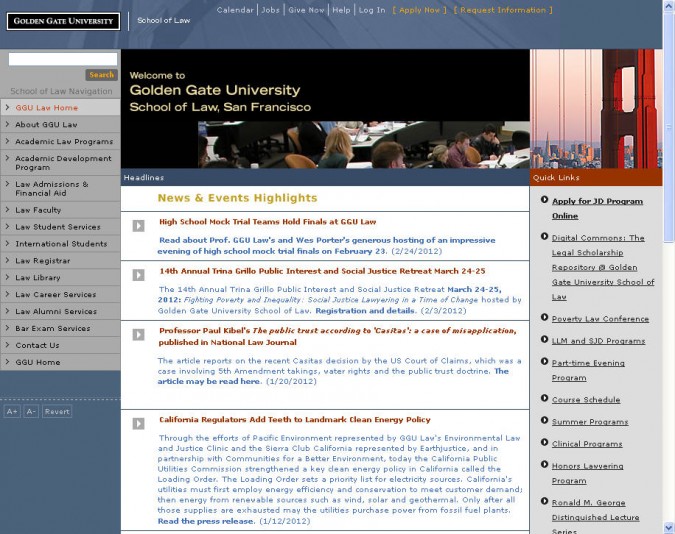
Front page of the law school website for Golden Gate University, February 25, 2012. The first link under News & Events links to KevinWarnock.com.
The lengthy blog post I wrote early Friday morning, February 24, 2012, about the San Francisco Mock Trial finals was linked to by the website for the law school at Golden Gate University.
Golden Gate University hosted the Mock Trial finals at their campus at 536 Mission Street, San Francisco, California USA.
The screen shot above from the law school website shows the link, dated 2/24/2012. That blog post received perhaps the highest one day traffic of any post I have yet written. Thanks to everyone that had a look.
Thank you to Golden Gate University for the recognition. I am glad I stayed up until 3 am authoring that post.
San Francisco Mock Trial finals held tonight at Golden Gate University

Mock Trial finalist teams gather for a group shot after their trial on February 23, 2012. The competing teams were from Lowell High School and School of the Arts. Photo includes: Marcus Wong, Negative Nancy, Havel Weidner, Malia Bow, Nico Scoliere, Cristina Rey,Elizabeth Levinson, Lena Gankin and others.
I have had a busy couple of evenings. Yesterday evening, February 22, 2012, I was at the Mentor Mixer for The Berkeley Startup Competition, which I have been involved with for years. The mixer was held at the offices of Morrison & Foerster at 425 Market Street in San Francisco, California USA. I am a mentor to one of the semi final teams this year, and I was at the mixer to meet my team for the first time.

Golden Gate University, 536 Mission Street, San Francisco, California, February 23, 2012. The finals for the 2012 San Francisco Mock Trials were held in room 2203.
On my way home on the Muni Metro, I had the good fortune to meet a very impressive young woman named Devon Ivie. She complimented me on my favorite red velvet jacket. We got to talking and it turns out we attended high school in San Francisco at the same place. It turns out she’s still in high school, though she graduates in May. Ivie told me about her involvement with San Francisco Mock Trial, which is an educational project where students pretend to be attorneys during a fake trial they conduct. She told me the public finals were to be held today, February 23, 2012, just steps from where we both boarded the subway train.

Team coaches for San Francisco Mock Trial 2012 finals held at Golden Gate University February 23, 2012. Left: Eleanor Hicks, Right: Courtney Shaw Huizar.

Devon Ivie playing prosecution attorney talks to student playing defense attorney at the San Francisco Mock Trial finals, February 23, 2012.
I did a Google search when I got home and found the Facebook page for the Mock Trial and asked a question there as to the exact room number where the event would be taking place at Golden Gate University, which teaches law among other subjects.
I received an answer so I decided to attend as a blogger, with the intention of covering the trial as a reporter of sorts.
I brought my Canon 5D Mark II camera with a 135mm telephoto lens, which I used to capture stills and video clips. Tonight after the trial concluded I selected the still photographs you see here. I uploaded to this blog the full resolution 21 megapixels shots and added captions, which took hours. Since it’s late, I don’t have the energy to write a proper article about the trial right now. But I wanted to get the pictures posted tonight so that both teams would be able to see them tomorrow, a Friday.
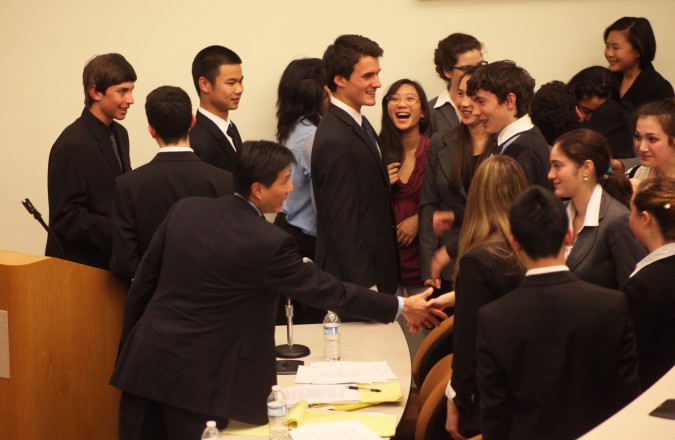
Both teams talk after the trial. Picture includes: Clifford Yin, Marcus Wong, Negative Nancy, Havel Weidner, Malia Bow, Nico Scolieri, Cristina Rey, Elizabeth Levinson and others. San Francisco Mock Trial finals, February 23, 2012.
I don’t randomly attend events strangers on the train tell me about. I was compelled to attend this event because when I went to high school, the school I attended was named McAteer High School. McAteer was a deplorable educational institution that was so bad the city of San Francisco eventually shut it down. The campus reopened later as The School of the Arts, or SOTA. Devon Ivie is a student at SOTA. She was an attorney for the prosecution in a murder trial at the mock trial tonight. She was outstanding, as were her fellow attorneys.
Ivie told me SOTA was competing in the city wide Mock Trial finals against Lowell High School, which is generally considered to be the best public high school in San Francisco. I was and remain impressed.
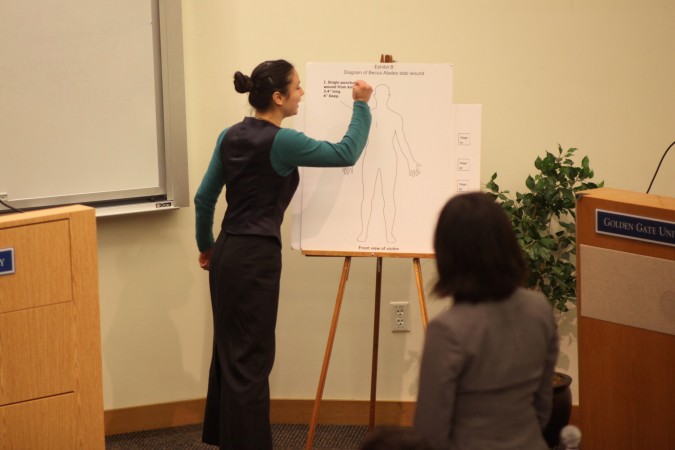
Student playing witness demonstrates to Cristina Rey playing attorney for the prosecution how victim was stabbed to death. Mock Trials final in San Francisco, February 23, 2012.
I attended the Mock Trial because I wanted to see SOTA students in action, to witness first hand how a dreadful school can be turned around into a place from where winning teams regularly emerge.

Malia Bow playing witness explains a trial exhibit to Devon Ivie playing prosecution attorney. San Francisco Mock Trial 2012 finals, February 23, 2012.
I had a fantastic evening at Mock Trial tonight. I met a teacher from Lowell and spoke with him for 20 minutes about the state of the education system in the United States. I met two additional SOTA students, including one on the subway coming to the event.
I got to meet one of the coaches for the SOTA team and I got to say hello to my new friend Devon Ivie, shown here in the 4th picture from the top of this post.
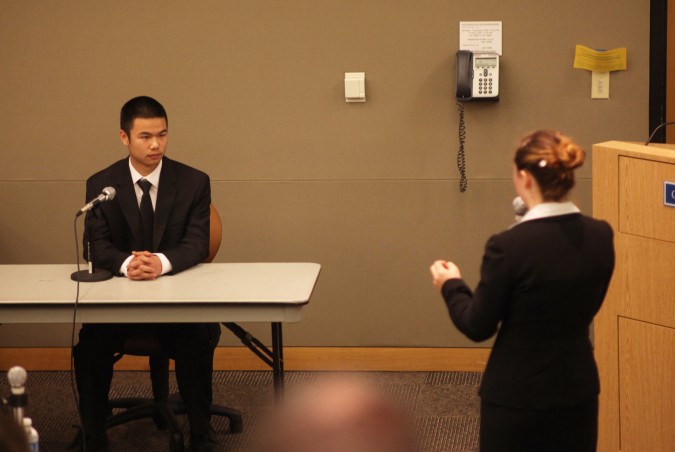
Marcus Wong, playing a police officer, is questioned by student playing attorney for the defense at San Francisco Mock Trial finals 2012, February 23, 2012
Within the next few days I hope to be able to write a proper article about tonight. Please subscribe to my blog to keep up to date with this and other stories I write. I am on Facebook, so please friend me there. My status updates frequently provide quick summaries and links to my blog, so friending me is a quick way to stay abreast of my blog without needing to visit it directly.
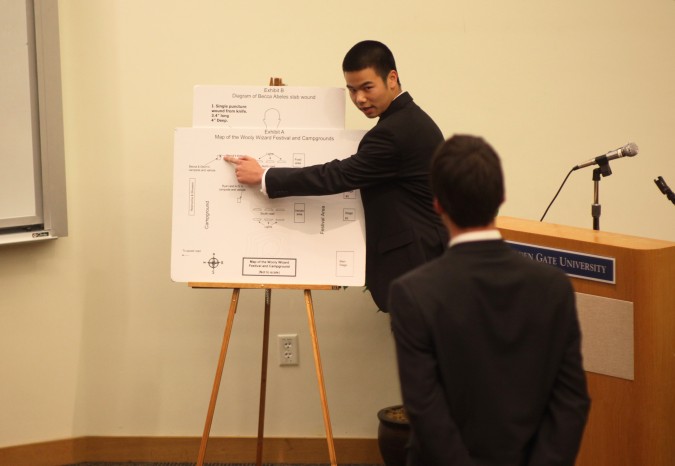
Marcus Wong, playing a police officer, explains exhibit to Havel Weidner, playing attorney for the prosecution, at San Francisco Mock Trial 2012 finals, February 23, 2012.
I posted these pictures to an album on Facebook. If you know people in these pictures and are on Facebook, please visit my album and tag the people so I can update the captions on these pictures. Thanks!
[Note: These pictures were tagged on Facebook after I posted them there. The pictures are publicly viewable on Facebook, so I copied the names of the tagged individuals to the captions underneath these pictures today, February 25, 2012. If you are identified on this blog post and prefer to have your last name removed, send me a message and I will edit this post. This post is not meant to invade your privacy. I would be thrilled if it helps you get into college or get a great job.]
I have a smart father
I like to think I am a smart and inventive guy.
I have two professional claims to fame:
I created the first online document assembly website (Hotpaper) and the first online office suite (gOffice).
Both of these categories of software proved to be quite popular.
In the United States, LegalZoom and Rocket Lawyer now dominate the online document assembly business.
In the United States, Google Docs and Zoho now dominate the online office productivity business.
I am proud that I created the first versions of these significant components to the fabric of the Internet.
While my contributions to the Internet may not have the sex appeal of the social network Facebook or the political influence of the micro-blogging website Twitter, my contributions do allow people to get real work done online.
Getting work done is important to the advancement of humanity. Friending and Tweeting also help advance humanity, but the importance of writing and communicating well with the help of productivity software and document assembly software should not be discounted. How long could you go without Microsoft PowerPoint, Word and Excel or their new online competitors? Probably not long if you are a white collar worker.
I bought a nice house in San Francisco with the spoils of my inventions, and I believe I lead a comfortable and richly satisfying life.
I am shockingly happy. I am surprisingly happy for Google, Zoho, LegalZoom and RocketLawyer — despite their making more money from my innovations than I did.
However, I am not smart like my father Robert Warnock.
Yesterday I learned that my father’s paper Hamilton-Jacobi Equation is included on the peer-reviewed ScholarPedia website.
ScholarPedia is a WikiPedia like website for scientific papers.
Creating an online office suite like I did is a piece of cake compared to what my father works on. Many smart 20 year olds today could build the software I was first to build. But I don’t think any 20 year old could write the papers my father writes, no matter how hard they tried.
Don’t think I am putting myself down by this post.
I am simply showing you how outstandingly bright my father is. My mother is also outstandingly bright, and I’m certain I got my smarts from them.
I regard myself as quite smart.
I continue to invent things on a weekly basis. My mind is frequently dreaming up improvements to many everyday problems. I will never have the time to implement even a small portion of all the crazy ideas I come up with. The best I can hope for is to write a minority of them down and publish them to this blog, where hopefully others will find and then implement them.
I am devoting considerable energy to developing ideas to improve the efficiency of living, including heating, cooling, food production and water usage. Look for many more thoughts from me on these subjects over the coming years. My hope is that my ideas in these areas will have a profound influence on the state of the human condition by the end of my life.
As a side note, I am impressed that Scholarpedia uses Web Fonts to display math equations. That means you can copy and paste the mathematical equations in articles published on Scholarpedia. You generally can’t do this on WikiPedia, where equations are entered as LaTeX source code but then converted to image files for display.
Dr. Janet Rowley wins prestigious Japan Prize in the field of healthcare and medical technology
Remember my post from January 7, 2012 where I shared my mother’s prediction that Janet Rowley, the mother of one of my classmates from elementary, middle and high school, would win a Nobel prize?
Today is January 25, 2012, and Dr. Rowley has won a prestigious prize.
It’s not a Nobel, but it’s getting close.
Dr. Rowley won the Japan Prize, in the field of healthcare and medical technology.
Rowley shares this Japan Prize with two others, Dr. Brian Druker and Dr. Nicholas Lydon. The annual prize has been awarded for 28 years.
Rowley, Druker and Lydon will equally share the generous 50 million Yen prize, today worth about USD $650,000 according the news release published by the Japan Prize organizers.
From the press release:
“Janet Rowley, M.D., Blum-Riese Distinguished Service Professor of Medicine, Molecular Genetics & Cell Biology and Human Genetics of the University of Chicago, Brian Druker, M.D., Director of the Oregon Health & Science University Knight Cancer Institute, and Nicholas Lydon, Ph.D., Founder and Director of Blueprint Medicines, were recognized for their contribution to the “development of a new therapeutic drug targeting cancer-specific molecules,” called Imatinib.”
and later in the same release:
“I am particularly pleased to share this award with my good friend and collaborator, Nick Lydon, and one of my personal heroes, Dr. Janet Rowley,” Dr. Druker said in his acceptance speech at the press conference. Speaking about the development of Imatinib, he said: “Today patients who once had a life expectancy of three to five years are now expected to live 30 years. With Imatinib, we’ve turned a fatal cancer into a manageable disease …. There are incredible opportunities in cancer research. What Imatinib tells us is that by understanding cancer we can develop effective treatments. Imatinib tells us we are on the right track but we can’t be complacent. We can’t be patient. We must seize this momentum to reach the finish line of curing cancer.”
I’m sure my classmate Roger Rowley will be talking excitedly with his mother today. Congratulations to all. I called my mother at 8:30 this morning to tell her the good news.
Who else has won the Japan Prize? Last year two of the developers of the UNIX computer operating system, Ken Thompson and Dennis Ritchie won the Japan Prize in a different category. Here’s a nice writeup on the Google blog. Thompson works at Google.
Please read the press release of Rowley’s win at the website of the Japan Prize. If that website link in the future breaks, you may then read this archived PDF version that I created so that this important document won’t be lost from my blog years from now.
Berkeley Startup Competition – please participate
Please participate in the UC Berkeley Startup Competition, formerly known as the UC Berkeley Business Plan Competition. Here’s the email notice I received this morning from the competition organizers. Since this link will eventually not work, I prepared a screen capture of the email and I show it below this paragraph.
My friend Kelly Karns of AutoTB is shown in the picture at the lower right of the email screen capture above. That’s Andre Marquis, the Executive Director of The Lester Center for Entrepreneurship in the lower left. Marquis is shaking things up and making changes — I wrote to him October 5, 2011 suggesting the name of this event be changed to The Berkeley Startup Competition, and today I open my email and the name has been changed. My suggestion may not have been unique, so I am not trying to take all or even a majority of the credit for renaming the premier entrepreneurial competition at Berkeley. But I will take my earned share, however tiny or substantial that turns out to be.
I made the name change suggestion to take the focus off of writing business plans that few will read or pay attention to. Instead, I want the focus to be on creating viable startups that create jobs and change the world. Achieving this goal will require a lot more than a new name, and I hope to be invited to contribute more of my many ideas to help reach this goal.
I was a finalist in this event in 1999 and my success I trace directly to this competition. I am grateful that the rules allowed me to compete. I am grateful the rules still allow me to compete, should I want to start a new company.
I have donated USD $20,000 to the competition since 2000 — I am that grateful.
The Lester Center has extended to me many perks beyond what I technically ‘paid for’ with this $20,000, and I thank them for their extraordinary generosity. For example, I’ve recently concluded a dozen year stint on the Advisory Council of the Berkeley Entrepreneurs Forum. I paid nothing for this membership during this dozen years, despite the Council being a fund raising mechanism for the Lester Center. I enjoyed dozens of fascinating dinners during this period, and I made a lot of smart and interesting friends by my membership, including Jerry Engel, Brian Goncher, Robert Dellenbach, Laura Oliphant, Sam Angus and Tom Kintner and by association his brother Avery Kintner. I will miss these twice yearly dinners, which I never missed unless I was out of California.
I am talking with Marquis to expand and extend my assistance to the competition over the next 14 years. There is so much more I can do to help, and the future looks bright under the stewardship of Andre Marquis and the leadership of the student organizers, who have the responsibility to run and perpetuate the event.
Occupy Cal protest at University of California at Berkeley November 15, 2011
I was at the Occupy Cal protest at University of California at Berkeley last evening, November 15, 2011. There were over 1,000 protesters there. The energy in the air was positive and infectious.
As far as I could detect, the Occupy Cal event wasn’t marred by the shooting of a Berkeley student by campus police earlier in the afternoon. That student later died at the hospital. That student, Christopher Nathen Elliot Travis, age 32, was a transfer student from Ohlone College in Fremont, California.
Haas School of Business Dean Richard Lyons addressed the school’s students this morning. Later, Lyons posted this letter to the Haas Newsroom and publicized it via the micro-blogging website Twitter.
My friend Heather Sepulveda went to Ohlone College before she transferred to UC Berkeley years ago — a very strange coincidence to be sure.
There was a drum beat to the protest, thanks to the talented musicians that showed up. One of the musicians looked to be about 60, and he said he had participated in the anti war protests at UC Berkeley in the 1960s. I feature some of the music in the video I am editing from the event, which I hope to post tomorrow. I got some great video, including of the camping tents being carried into place.
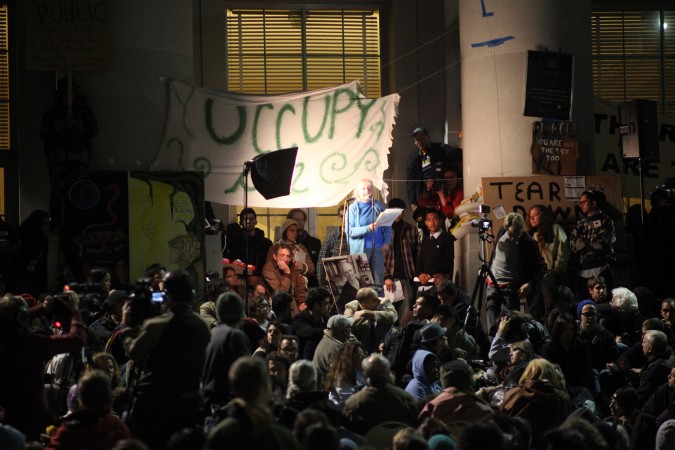
Board member of the Mario Savio Lecture Fund addressing Occupy Cal protesters November 15, 2011 at Sproul Plaza
The event incorporated a gathering of The Savio Lecture Fund, which originally was to take place indoors at the Pauley Ballroom in the Martin Luther King Jr. Student Center, also on the UC Berkeley campus. My guess is the change of venue was decided close to the last minute to benefit from the association with the Occupy Cal movement. I was not previously familiar with Mario Savio, I am embarrassed to admit. I concluded from the talks I heard last night that Savio would have embraced the Occupy Cal movement and message. Savio spoke on December 2, 1964 from the same steps of Sproul Hall where the speakers last night spoke from.
The Savio Lecture speaker last evening was former United States Secretary of Labor Robert Reich, who is a Professor of Public Policy at UC Berkeley. I captured his speech to high definition video and presented it on my blog earlier today.
In the photograph above you can see some of the camping tents already in place, along with another tent being carried into place already set up. Organizers were distributing hot food on the Sproul Hall steps. Even though there were a lot of people there, it was possible to easily move among the crowd, and I had no trouble taking pictures and video, even though I had brought a tripod with me, for many of the time exposures I took to capture the low light images you see here.

Soap bubbles by the hundreds liven up the view from the steps of Sproul Hall during Occupy Cal protest at UC Berkeley November 15, 2011
I took the above shot right before I departed, after 10pm. The group front and center appeared to be in their 50s and 60s. The age mix of the crowd was inspiring — it definitely wasn’t just current students in their teens and twenties. I felt that people were really passionate about the Occupy movement, and that this movement will be long lived and will accomplish real change in the world. I am glad I made the trip from San Francisco.
I uploaded these pictures at full 21 megapixel resolution. To see them at full size, click on them twice, with a pause in between the clicks to allow the photographs to load in a separate window. If you’d like to use these pictures for something, please give me a link back to my blog. If you like this blog, please subscribe, and please add this post to your status feed on Facebook. Thank you!
Robert Reich – Class Warfare in America, presented by The Mario Savio Memorial Lecture series at Occupy Cal, November 15, 2011
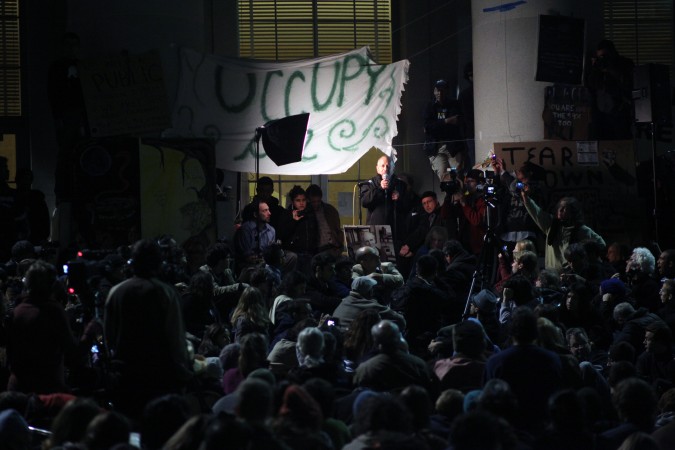
Robert Reich delivering speech 'Class Warfare in America' on Sproul Hall steps at UC Berkeley during Occupy CAL protest on November 15, 2011
I attended the Occupy Cal protest at University of California at Berkeley last evening, November 15, 2011. There were over 1,000 protesters there, including many approaching retirement age that indicated by a show of hands that they had earlier been there protesting in the 1960s and 1970s. It was an electrifying event that I will cover in detail in another blog post.
The event was made more thrilling by a speech given by Robert Reich, a professor of public policy at Cal. Cal is an abbreviation for University of California at Berkeley, for my readers unfamiliar with the word. The definition of Cal is well known locally, but on the world stage UC Berkeley is better known.
Reich was United States Secretary of Labor under President Bill Clinton. Reich is also a frequent commentator on NPR (formerly National Public Radio) in the United States. NPR is my favorite radio station, and I’ve heard Reich speak many times on the air. Last night was the first time I’ve seen him speak.
I brought my tripod and set up my Canon 5D Mark II camera with two of the legs touching one of the Occupy Cal camping tents that had earlier been set up before the steps of Sproul Hall at Sproul Plaza. This was a fantastic vantage point because the tent was already blocking the view of those sitting behind it, so my tripod didn’t appreciably further block the view. I simply sat on the pavement while the camera recorded. I recorded the full speech, and you can watch it in the video below. This is a compressed upload, but I have the full 7 gigabyte file in full HD. If you need the file for some project, please contact me.
Reich’s talk was very well received by the audience, including the tent dwellers sitting right next to me who graciously allowed me to set up there.
It was an inspiring and powerful speech. I am not going to try to summarize it since it’s brief and presented here in its entirety. I encourage you to watch it all the way through, and share it with your social network. I was so taken with it that I stayed up late into the morning editing and compressing the video so I could get this posted today during the day.

